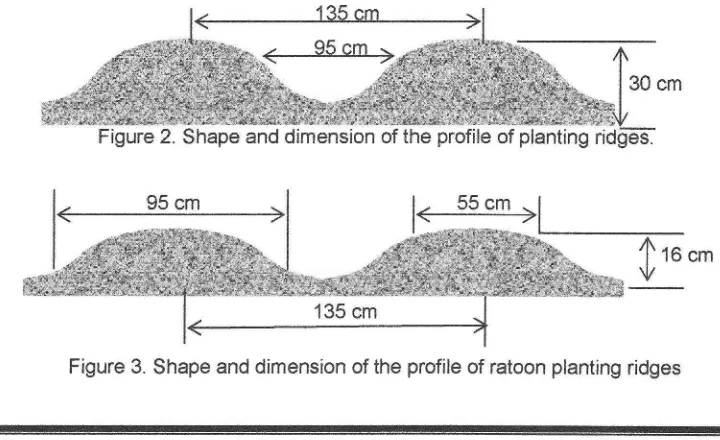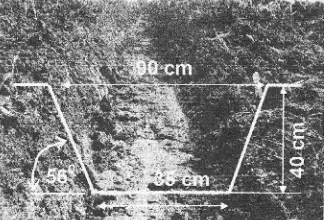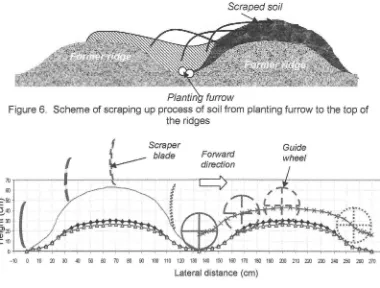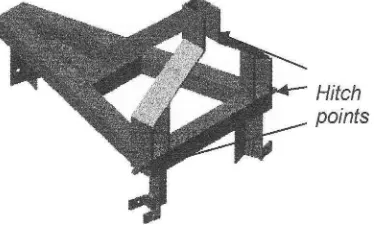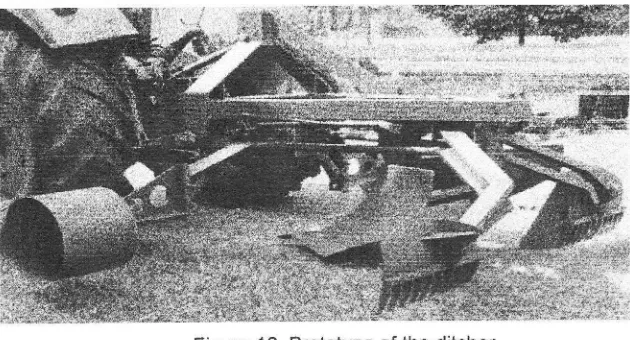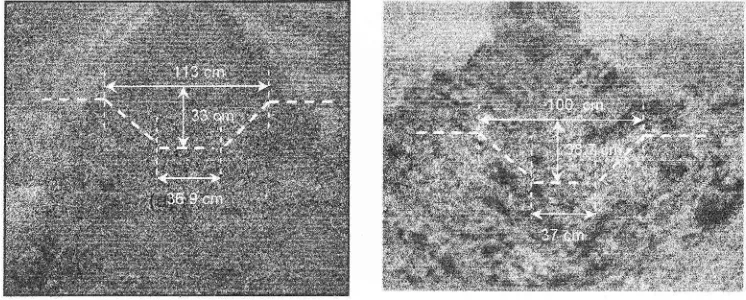A
E
SA
PROCEEDINGS
Bogor, Indonesia, November 17-19,
P E R T E T A
2
0 0
9
International Symposium
AGRICULTURAL ENGINEERING TOWARDS
SUSTAINABLE AGRICULTURE IN ASIA
Editors :
TABLE OF CONTENTS
PREFACE
GROUP A :FARM MACHINERY AND MANAGEMENT (FMM)
Screen Types Affecting Efficiency of Soil Separation from SugarCane
Stalks (Y.Suphan W.Seree and L.Juckamas) 1
Design of Simple Nyamplung Oil Presser (Puspitahati, Tri Tunggal, Edward
Saleh) 9
Optimum Soil Tillage Method on Dry Land Sugarcane Cultivation (Gatot
Pramuhadi) 16
Application of Neuro-Fuzzy Controller to Autonomous Agricultural Vehicle Operating on Unstructured Changing Terrain- Control Software
Development (Lilik Sutiarso, Tomohiro Takigawa) 24
Analysis on Optimal Sugar Cane Harvesting System in Jatitujuh SCP, Majalengka
(Setyo Pertiwi and Vidy Haryanti) 34
City Waste Reduction Efforts for Environmental Quality Improvement (Trough Improved Agricultural Commodities Distribution System)
(Emmy Darmawati) 42
Specific Soil Draft Resistance of Some Mould Board Ploughs Performed in
Wetland Paddy Soil (Ade Moetangad Kramadibrata) 52
Mathematical Model for Turf Grass Mowing Torque by Using Rotary-Type
Mower Blade(INengah Suastawa, Siti Suharyatun) 59
Machine Vibration Analysis for Determining Optimum Operational Engine Speed
(Gatot Pramuhadi, Mad Yamin and Siti Khoirunnisa) 72
Two Wheels Hybrid Com Seeds Holes Maker (TWHYCOM) (Astiti Puriwigati,
Arief Sabdo Yuwono) 76
Development of Push Type Rotary Mower Powered by Engine of Back Pack Brush Cutter (A Modffication from Potrum BBE-G1 Prototype to
Potrum BBE-G2 Prototype) (I Nengah Suastawa) 86
Design of a Ditcher Equipped With Scrapers for Making Drainage Channel
on Dry Land Sugar Cane Plantation (Wawan Hermawan, 1 Nengah
Suastawa and Samsul Bahri) 95
Design and Traction Performance of Movable Lug Wheel Equipped with
Spring Mechanism (Wawan Hermawan) 103
Development of Powered Disk Type Sugar cane Stubble Saver (Radite
PAS., Lisyanto,1N. Suastawa) 111
Evaluation of Diesel and Farm Tractor Performance Powered by
Cocodiesel (CME)(Desrial) 121
Development and Testing of Automatic Sorting and Grading Machine for Citrus (Usman Ahmad, Mardison S., Rudy Tjahjohutomo, and Ana
Nurhasanah) 132
Sieving Effect of Sorting Machine with Vibration Table Type on Cocoa Pod
Based Compost(Siswoyo Soekarno, Edy Suharyanto, Ahmad Hudi Arit) 142
Mechanical Cocoa PodbreakerUtilization in Cocoa Handling for Improving Labor and Production Efficiency (Sukrisno Widyotomo, Sri mulato and
Siswoyo Soekamo) 152
The Effect of Tractor Traffic and Organic Matter on Soil Compaction and Performance of Peanut Crop (Iqbal, Tineke Mandang, E. Namaken
Sembiring) 162
GROUP B:LAND, WATER AND ENVIRONMENT
Development of ANN Extension on Arcview-GIS for Prediction Land
Plantation Productivity(Hermantoro Sastrohartono) 169
Hydraulical Approach in Designing of Proportional Division Structures in
Traditional IrrigationSchemes(M. Hasan Yahya) 176
Plant Speaking Approach For Automatic Fertigation System In Greenhouse
(Usman Ahmad, I Dewa Made Subrata, Chusnul Arit) 185
Study on Phisic & Hidro-Meteorologycal Characteristics of Two Identical
Catchments(Indarto and Sri Wahyuningsih) 194
Landuse Classification Using Aster Multispectral Data : Case StUdy at
Sampean Watershed (East Java)(Indarto and Arit Faisol) 204
Land Use Classification at Sampean Watershed Using Multispectral Spot
Image(Januar Ferry Irawan and Indarto) 213
Development of Digital Elevation Model For East Java (DEM-JATIM) Using
Catchmentsim and Mapwindow GIS(Indarto) 220
Climate Change Adaption Using Reservoir Rule(M. Yanuar J. Purwanto) 231
Quantification of Methane (CH4) Gas Emission as selection Parameter of
Rice Variety(P. Setyanto, S. Ambarwati, Ariet Sabdo Yuwono) 240
Trend Study of Greenhouse Gases Emission and Carbon Balance of Several of Rice-Plant Management System (P. Setyanto, Isminingsih,
Rina Kartikawati, Arief Sabdo Yuwono) 247
Analysis of Water Absorption at Bandarlampung City (Ahmad Tusi and Moh.
Amin) 255
Evaluation of Moments on Water Scoop-Wheel (Kincir) for Irrigation By
Kincirmod (Mohammad Agita Tjandra) 265
The Environmentally Design of Water Management System for Sustainable
Peat Land Development in Indonesia (Dedi Kusnadi Kalsim) 274
Urban Water Demand on Interbasin Water Resources Management System
(Sutoyo, M. Yanuar J. Purwanto, Kato Tasuku and Goto Akira) 285
Tide-Aquifer Interaction Dynamics in Unconfined and Confined Coastal
Aquifer Systems (Madan K. Jha, Yasunori Kamii) 297
Model 20 of Bank Erosion for Non Cohesive Soil River Banks (Case Study
: Sorachigawa River, Hokkaido Japan) (Januar Fery Irawan) 310
Intelligent Computation of Potential Land for Food Production Using a Spatial-Based System (Rakhmat Jaya Lahay, Kudang B. Seminar, Ade
Komara Mulyana) 319
Determining Defferences in Soil Organic Matter Content Between Two Compost Types Used in Urban Agriculture (Ida Ayu Gede Bintang
Madrini, Sakae Shibusawa) 331
Design of Supervisory Environmental Parameter Ammonia (NH3) Control of Closed House System Model For Broilers (Alimuddin, Kudang Boro
Seminar, I Dewa Made Subrata, Sumiati) 342
Influence of Water in Sri Method to Yield and Growth of Paddy Hybrid Variety on Field Experimental Plot at Desa Gemuruh, Kundur Islan,
Karimun Regency, Kepulauan Riau Province (Wagiono) 354
Utilization of Sidoarjo Mud to Develop Pitcher for Irrigation (Budi I.
Setiawan, M.Bagus Hermanto, Agus Pakpaha) 363
SESSIONC :FOOD AND AGRICULTURAL PRODUCTS PROCESS ENGINEERING (FAPE)
Drying Characteristics and Quality Attributes of Asiatic Pennyworth
Leather (Wiriya Phomkong, Nittiya Homhuan, SUkanya Noranate) 371
Degradation of ascorbic acid during preparation and heat treatment of
syrup from guavafruit(Psidium guajava) (Indera Sakti N) 383
Non Destructive Inner Quality Prediction In Intact Mango With Near
Infrared Reflectance Spectroscopy (Agus A. Munawar & f Wayan
Budiastra) 391
Effects of Water contents and Packaging Materials on Storage Life Time of
Stick Sweet Potato Chip (Tamrin & LelaAmeli) 400
Simple Refining Technique of Coconout Oil for Small Holder Industries
(Sugeng Triyono and Agus Haryanto) 406
Effect of Heat Shock Treatment and Aloe Vera Coating to Chilling Injury Induced in Tomato (Sutrisno, Y. Aris Purwanto, Sugiyono, Ismi M. Edris,
Oily S. Hutabarat) 413
Improving Volatile and Lipid Quality of Macadamia Nut Through the Use of Hybrid Drying (Phatanayindee, S.,Borompichaichartkul,G. ,Craske,J.and
Wooton,M) '" 420
3D Visualization of Cell Membrane of Cucumber Fruits Stored Under Chilled and Non Chilled Temperature (Yohanes Aris Purwanto, Seiichi
Oshita, Yoshinori Kawagoe, Yoshio Makino) 427
Study of Respiration Rate and Texture of Bali Snake Fruit Using Polyethyline Plastic Packaging During Modified Atmosphere Storage
(I.A. Rina Pratiwi Pudja) 434
Preparation of Styrene and Methyl Methacrylate Grafted Onto Natural
Rubber (Ahmad Randy, Dewi Sondari, Kuntari AS., Ariadi B., Surasno) 439
Improvement of The Technology Packaging for The Transportation of
Mangosteen (Niluh Yulianti, Sutrisno, Emmy Darmawati) 444
Influence of Potassium Persulfate Initiator in Emulsion Polymeryzation of Polymethyl Methacrylate Onto Natural Rubber (Dewi Sondari, Agus
Haryono and Evi Triwulandari) 452
Ultrasonic Wave Characteristic of Arumanis Mangoes and Damage
arumanis mangoes by fruit fly (Warji and Rokhani Hasbullah) 460
Biodegradable Plasticizers From Isobutyl Oleate Based on Palm Oil as The
Substitute of Dop on PVC Resin (Evi Triwulandari and Agus Haryono) 469
Technical Performance Evaluation of Cooffee Bean Roaster with Rotating
Cylinder Type (Sutarsi, Siswoyo Soekamo and Sukrisno Widyotomo) 479
Thin Layer Charateristic of Fermented and Unfermented Cocoa Beans (S.
Salengke) 488
Determination of Soluble Solids Content (SSC) of Orange and Lemon by a Portable NIR Spectroscopy (Rudiati Evi Masitoh, Sumio Kawano,
Sirinnapa Saranwong) 500
Identification and Quantitative Analysis of Catechin in Dried "Gambir"
Leaves Extract (Devi Yuni Susanti, Umar Santoso, Kapti Rahayu) 508
Mathematical Model of Heat Transfer During Compression at Tablet
Processing (Ansar, Budi Rahardjo, Zuheid Noor, and Rochmadi) 519
The Novel of Benzaldehyde In Controlling the Growth of Green Mould
(Penicillium Digitatum) Valencia Oranges (I Made S. Utama) 528
Characteristic of Six Indonesia Corn Grains and Their Flours (Titi C. Sunarti,
Riyahi, N.A. Permatasari, N.Richana, F. Kasim) 538
Retention Pond Design and Charateristics Modelling in Fermented Pulp
Cocoa (Pandu Gunawan, Gardjito) 548
Grafting Ability of Plasticized Tapioca on Poly (butylenes
adipate-co-terephthalate) (Raffi Paramawati, Weipeng Liu, Ramani Narayan) 559
Characteristics of Easter Lily Flower (Lilium longitflorum Thunb) in Cool
Storage (I.A. longdong, D. Tooy) 570
Fruitfly Disinfestation of Mango cv Gedong Gincu Using Vapor Heat
Treatment(VHT)Method (Rokhani Hasbullah, Elpodesy Martisa, Dadang) 579
Group D : GLOBAL ISSUES (BIOENERGY AND RENEWABLE ENERGY, WORK SAFETYAND ERGONOMICS) (GIS)
Kinetic Model of Biodiesel Processing with Ultrasound (Bambang Susilo) 590
Effect of Crude Glycerol Addition on Hardwood Ships Gasification Using a
Downdraft Gasifier (Agus Haryanto, lester R. Pordesimo, Sandun D.
Fernando, JamesR.Wooten, Eugene P. Colombus, Lin Wei) 600
Performance of Pressurize Stove by Utilizing Plant Oils in Indonesia
(Bambang Prastowo, Srimulato and Elita Rahmarestia) 610
Comprasion of Two Burners on Charcoal Yield and Compositons
(W.Songchai, Y. Suphan andl. Juckamas) 618
Production of Charcoal Mixed with Egg - shell (Bopit Bubphachot and
Songchai Wiriyaumpaiwong) 623
Energy Auditing in Urea Production Process (Case Study in PT Pupuk
Kujang-eikampek, West Java) (S. Endah Agustina and Hera Pratiwi) 630
Sustainability Parameters in Dissemination Renewable Energy
Technologies (Kamaruddin Abdullah) 641
Supporting ESSV Program with The E31 Village Concept (Karnaruddin
Abdullah) 648
Design of Rotary Rack Type Greenhouse Effect (GHE) Hybrid Solar Dryer
for Cardamon (Wulandani, D., S.E Agustina, Y. Aris Purwanto,
l.O.Nelwan) 657
Analysis of Energy Consumption for Paddy Production in Indonesia
(Agung Hendriadi and Lilik Mulyantoro) 666
Sesslon A: Farm Machinery and Management (FMM)
Figure 1. A ditch produced by a furrower.
The objective of the research was to design a ditcher equipped with a pair of scrappers pulled by a four-wheel tractor. The ditcher operated without using PTO. lt
is
requested thatthe
prototypecan
produce drainage channel with trapezoidal shape [1] with the lower side of 35 cm, upper side of 90 cm, and depth of 40 cm. lt isalso able to scrape and place the dug soilon the top of initial ridges.
RESEARCH METHOD
Field and tractor identification
As fundamental information for designing the ditcher, field characteristic of sugar cane planting area in Jatitujuh Sugar Cane Plantation was identified. Shape and dimension of the profile
of
planting ridges were measured, and the result ispresented in Figure 2 (plant cane ridges) and Figure 3 (ratoon cane ridges)"
Figure 3. Shape and dimension of the profile of ratoon planting ridges
+-g5im+
Figure 2. Shape and dimension of the profile of planting ridges
lnternational Symposium Agricultunl Engineering Towards
Suistainable Agriculture in Asia, Bogor, lndanesia, November 18-19, 2009
Sessron A: Farm Machinery and Management (FMM)
Physical properties and mechanical properties (cone penetration resistance, plate penetration resistance, shear resistance, etc.) of the soil were also measured. Furthermore, three point hitch specification and general dimension of the tractors used for pulling the ridger were identified and measured.
[image:9.595.243.405.216.326.2]Drainage channel produced
by
a
rotary ditcherat
the
planting area was identifiedand
measuredas
presentedin
Figure3.
This
ditch dimension was preferred to be producedFigure 4^ Cross section of a ditch produced by a rotary ditcher. Conceptual design
There were two main processes that should be performed by the ditcher:
1)
cutting-across the ridge and throw the soil to the right and left side of the ditcher in making the drainage channel across the planting ridges,2)
scraping the dug up soil in between the planting ridges and put it on the top of the ridges.There were several concepts for performing these processes and making the preferred ditch, and following is the best concept selected on evaluation process. For the
first
process,a
conventional furrower designas
introducedby
several authors [4,5]
as shownin
Figure5
(a)is
selectedfor
simpler construction. The cutting section should be able to cut the soil as the bottom of the ditch at 35 cmwidth. The moldboard shaped wing section should be able to lift up and throw the dug up soil
to the
left and right sides of the ditcher. For the second process, ascraping mechanism is designed, which consists of two main parts: a) scraper blade, and b) motion mechanism for the scraper blade. Since the scraper blade at the right and left sides of the ditcher should scrape up the soil in between the planting ridges and put the soil in the top of the ridges, the motion mechanism should be able to move the scraper blade as required. Furthermore, since the scraper blade should move up and down without using any power resource, the motion is performed by utilizing the ridge profile and a guide wheel which rolls on the ridges and move the scraper
blade.
The up-down motion of the wheel is utilized and connected to the scraper behindthe
wheelby
a
rotating shaft (see Figure 5(b)).By
using the mechanism, the scraper moves up-down simultaneously with the guide wheel.lntemational Symposium Agicultunl Engineeing Tawards
Suistainable Agiculturc in Asia, Bogor, lndonesia, November 18-19,2009
the new type of ditcher.
Session A: Farm Machinery and Management (FMM)
Four-bar linkage
(a)
{b) Figure 5. Design concepts of ditcher (a) and scraper (b). [image:10.595.143.503.136.306.2] [image:10.595.120.500.375.663.2] [image:10.595.122.508.518.655.2]The mechanism was designed by analyzing the motion path of the scraper as resulted by the guide wheel movement, as shown in Figure 7. Since the required moving amplitude of the scraper is bigger than the wheel amplitude, the four-bar linkage of the scraper should be longer than the four-bar linkage of the wheel.
Figure
6.
Scheme of scraping up process of soil from planting furrow to the top of the ridgesForward direclion
Guide wheel
7D
60
c
o40
or*
o
Ir0
0
(
t
l-10 0 10 B 3l 40 50 60 70 80 s 1m 110 120 130 140 '15U 160 170 18U 10 200 t10 2E ?30 2€ 250
Lateral distance (cm)
Figure
7.
Scraper motion path as generated by the guide wheel movement. Scraped soi/?50
lnternatianal Symposi um Agicultunl Engineering Towards
Suistainable Agiculturc in Asia, Bagor, lndonesia, November 18-19, 2009
Sesslon A: Farm Machinery and Management (FMM)
For installing all parts of the ditcher and hitching to the tractor, a frame was designed at a proper strength and function. The concept is shown in Figure 8.
[image:11.595.230.417.195.308.2]Hiteh points
Figure 8. Design concept of the frame.
Performance testi ng method
A
prototypeof
the
ditcherwas
fabricated basedon the
design result. Furthermore, performancetests were
conductedat
the
Experimental Field of Agricultural Engineering Department, IPB and Jatitujuh Sugar Cane Plantation. Testing plotswas
preparedat
the
same conditionas the
sugar cane planting condition, including similar size of planting furrows. Soil condition on the ridge was measured beforethe
test, comprised soil bulk density, water content, and cone penetration resistance.The
prototypewas
hitchedto
a
four-wheel tractorand
set at
a
proper operation depth. During the operation, average fonvard speed was measured to get the field capacity of the ditcher. Ditches resulted by the ditcher were observed, and their cross sections dimension were measured using a relief-meter. The profile of planting row was also observed and un-scraped soil on the furrow bottom was measured.To identify the power required for pulling the ditcher,
a
set of measurement was eonducted. ln the measurement, the ditcher was hitched to a tractor (Tractor-2) which was pulled by another tractor (Tractor-1) and a load-eell was set on the steel towing cable between the two tractors to measure the pullforce (Figure g). The draft force of the ditcher was determined by subtracting pull force in pulling un-worked ditcher from the pull force in pulling the worked ditcher.International Symposium Agicuttunl Engineeing Towards
Suistainable Agiculture in Asia, Bogor, lndonesia, November 18-19, 2Q09
Sessron A : Farm Machinery and Management (FMM)
Handy-strain meter
Load cell Ditcher
L;io,..
t
t
i
Ridges
Figure 9. Ditcher draft force measuring method.
RESULTS AND DISCUSSION
The prototype of the ditcher
Based on design analysis and several adjustments, a prototype of the equipped with scrapers was fabricated as shown in Figure 10.
lnternational Symposium Agricultunl Engineeing Towads
Suistainable Agiculture in Asia, Bogor, lndonesia, November 18'19,2049
ditcher
The prototype of the ditcher was equipped by
a
pair of soil scrappers. The function of the ditcher isto
make the drainage channel, whereas function of the scrapper is to scrap up the soil in between the ridges and put it on the top of the 6dges. Scraping mechanism was driven by a guide wheel that rolled on the ridge's profile. The drive force then was transmitted through a transmission shaft to drive the scrapper. The structure of the scraper ditcher consisted of a frame, a ditcher, and a pair of scrapers. The frame had a triangular shape and equipped with three standardized hitching points. The ditcher had share cutting angleof
70o,60
cm [image:12.595.117.481.136.247.2] [image:12.595.147.462.353.523.2]cutting width, share intersection angle
of
15o, and the concaveness radius of the moldboard of 65 cm. The construction of the scraper driver consisted ofa
pair of guide wheels (41 cm in diameter), wheel arm (28 cm in length) and a pair of scraperFigure 10. Prototype of the ditcher.
Session A: Farm Machinery and Management (FMM)
blades (40 cm x 55 cm in size), scraper arm (68 cm in length). The dimension of the prototype was 173 cm in length, 293 cm in width, and 138 cm in height, and the weight is 435 kg.
Field performance of the ditcher
The result of performance tests showed that the ditcher operated successfully. The ditcher produced the expected trapezoidal cross section drainage channel with
a
proper sizeas
expected. The test resultat
Experimental Fieldof
Agricultural Engineering Department, IPB showed that the average length of lower side, upper side and the depth of the ditch were 39.1 cm, 113.1 cm and 33.1 cm respectively.\Alhereas, the test result at Jatitujuh Sugar Cane Plantation showed that the average length of lower side, upper side and the depth of the ditch were 37.9 cm, 100.2 cm
[image:13.595.128.501.311.461.2]and 38.7
cm
respectively (Figure 11). The cross section and sizeof
the
ditch produeed by the ditcher were sufficient for drainage purpose [1, 2].Figure 1
1.
Profile of ditches produced by the dither: (a) at Experimental Field ofAgriculturalEngineering Department, lPB, and (b) at Jatitujuh Sugar Cane Plantation (b).
As observed on the field tests, the scrapper could scrap up the discharged soil and then placed
the
soilon the
ridges. However, there was un-scraped soil inbetween the ridges which has 6 cm in height (at Experimental Field), and 15.8 cm in
height (at Jatitujuh Sugar Cane Plantation).
The draft force of the ditcher operated at Experimental Field was 2.84 kN at the average speed of 0.31 m/s. The average wheel slip of the tractor was 37.60/o.
Test result at Jatitujuh Sugar Cane Plantation showed that the average draft was 6.49 kN, which was bigger than that of the Experimental Field. lt was due to the heavier soil of the Jatitujuh Sugar Cane Plantation, and deeper working operation of the ditcher [3]. The soil condition and working condition caused the high draft and forced the tractor to have a high wheel slip. As measured at the test, the average wheel slip was 63.40/o. The average working speed was 0.57 m/s. Actually, this
I nte rn ati o n a I Sy m posi u m Ag ri cu lt u ra I E ng i nee
i
ng T ow a rdsSuistainable Agriculturc in Asia, Bagor, lndonesia, November 18-19,2009
Session A : Fann Machinery and Management (FMM)
speed was higher than the average speed of the rotary dither (0.34 m/s), but it was lower than the average working speed of the tractor pulling a furrower (0.87 mls).
coNcLusroNs
1.
A prototype of a ditcher equipped with scrapers for making drainage channel onsugar cane plantation has been designed and fabricated.
2.
The ditcher workedwell
in
makingthe
drainage channelat a
proper cross section size with the field capacity of 6.85 halhour. The cross section of the resulted ditches was trapezoid with the dimension of 38.7 cm depth, 37.9 cm lower side, and 100.2 cm upper side.3.
The scraper could scrap up the discharged soil and then placed the soil on the ridges.REFERENCES
1.
Schwab, G.O., Frevert, R.K., Edminster,T.W,
Barnes K.K. 1981. Soil and Water Conservation Engineering. John Wley and Sons, lnc. New York.2.
French, R.H. 1985. Open-Channel Hydraulics. McGraw-Hill Book Company, New York.3.
Gill, W.R., Vanden Berg G.E. 1968. Soil Dynamic in Tillage and Traction. Agric. Res. Service. US Departement of Agriculture, USA.4.
Gangde,C,N,
Kolte, N,N, Verma,P.P.
1996. Testingof
Bullock-operated Variable Wdth Sugarcane Ridger. lnt. J. Agric" Mech.MLA
;27:46-48.5.
Srivastava, A.K., Georing, C.E., Rohrbach, R.P. 1996. Engneering Principles of Agricultural Machines. American Society of Agricultural Engineers, USA.lnternational Symposium Agicultunl Engineeing Towads
Suistainable Agiculturc in Asia, Bogor, lndonesia, November 18-19, 2009
